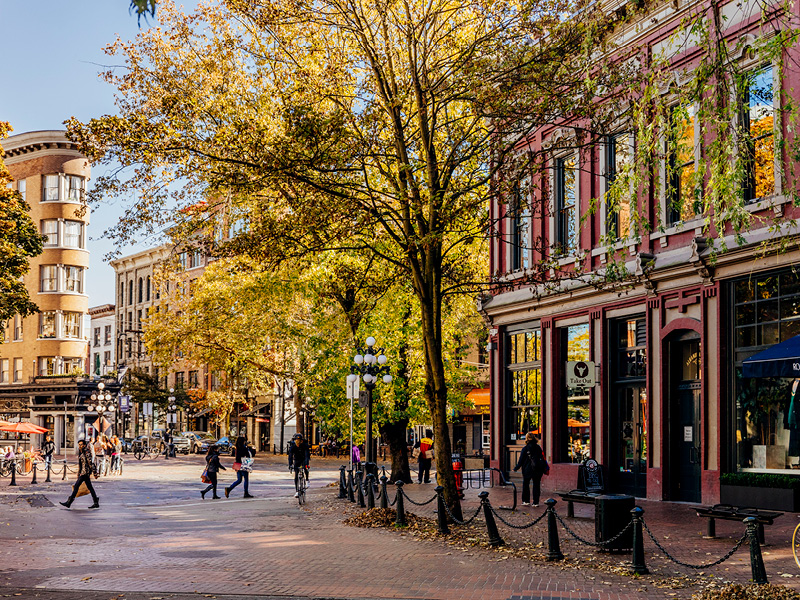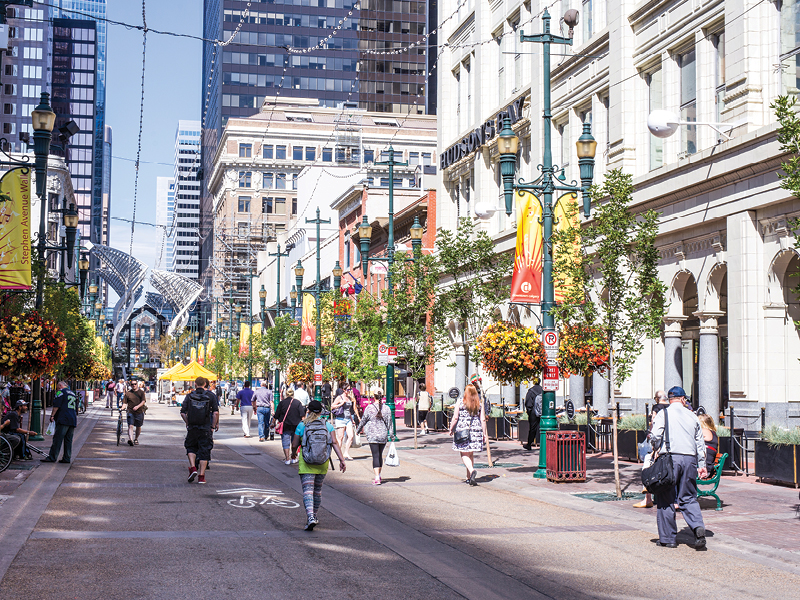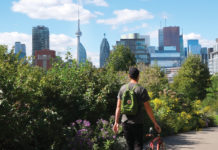We work out, eat better and sleep more to try to live healthier lives. But have you ever thought about all of the factors that go into helping you actually live that life? IMPACT Magazine is launching a new department dedicated to Living Healthy, opening a new opportunity to tell stories and share advice on healthy options for your home, your body, your mind, your spirit, even your neighbourhood.
Our first offering looks at how walking can create a fit community. As a bonus article, we are raising questions about what goes into the clothing you wear and what’s the impact on your health and the environment.

Brock Campbell lives a short walk to Calgary’s trendiest entertainment strip on 17th Avenue SW, a few blocks from the grocery store and food shops, his yoga studio, gym and 2K from work at a downtown office tower. He walks everywhere.
“I like living in an urban environment and I really enjoy not relying on a vehicle to get everything I need,” says Campbell, 27, an oil and gas engineer. “To get the essentials by foot is something that I really value. It’s a lifestyle.”
And that lifestyle is crucial to Campbell’s health. He lives in a fit community.
“We’re really talking about walking when talking about healthy neighbourhoods,” says Beverly Sandalack, associate dean at the University of Calgary’s faculty of environmental design. “If a neighbourhood isn’t allowing people to walk, we’re doing something wrong.”
Sandalack and colleagues have been researching healthy neighbourhoods, analyzing street patterns and amenities, then correlating their research with personal health indicators, such as waist size, to determine whether our neighbourhoods are making us sick, or letting us live full lives.
Calgary has been Canada’s fastest growing big city over the past two decades. It recently surpassed Ottawa as the country’s fourth largest urban municipality. But this growth has evolved around car culture, urban sprawl and thousands of homes continually built on the city’s perimeter. Those suburban neighbourhoods are characterized by their curved streets and cul-de-sacs that look interesting on Google Earth, but serve to trap occupants in their homes or vehicles. At 825 square kilometres, Calgary sprawls farther and wider than Toronto, Vancouver or Montreal with far fewer people. Big homes and large suburban lots can be attractive, but requiring a vehicle for every trip to the corner store, long work commutes and getting kids to school doesn’t make for a healthy lifestyle.
At its simplest, U of C researchers have found that people tend to be fitter and weigh less when they live in neighbourhoods with grid-patterned streets that are within a 15-minute walk of amenities such as grocery stores, transit stops, schools and work places. People in those neighbourhoods walk for transportation and to public transit. They walk for errands and to socialize at local coffee shops and eateries. Researchers found that both urban and suburban residents tend to walk about the same amount for leisure, but it’s those trips with a purpose that lead to better health and fitness.
Inactive people are almost twice as likely as active people to suffer from cardiovascular disease, stroke, hypertension, colon cancer, breast cancer, diabetes, depression and obesity. And with only one in five adults getting the recommended 150 minutes of moderate physical activity a week, we need to use every means possible to keep people moving.
“Your neighbourhood can enable or restrict the amount of physical activity you undertake, even for highly motivated people,” says Gavin McCormack, associate professor at Calgary’s Cummings School of Medicine. “Neighbourhoods that have many destinations, well-connected pedestrian networks, sidewalks, transit stops and pathways and cycleways encourage higher levels of physical activity.”
While there are many factors in play when people choose where to live — including affordability — urban planners say cities need to offer more choices that promote a lifestyle that is better for your body and the environment. Choosing a home has to be about more than the number of bedrooms and bathrooms inside.

Katherine Moore, a 39-year-old yoga instructor and competitive runner, lives in the heart of Vancouver, Canada’s most walkable city. According to walkscore.com, Moore’s Yaletown neighbourhood scores a near-perfect 99 on its rating scale, falling into the Walker’s Paradise category.
“I chose my apartment so I can walk to work, I can walk everywhere. I’d rather pay a little more in rent and I don’t need a car and I can stay active,” says Moore, who estimates she walks about 30K a week, on top of run training of about 100K. “I can’t think of my life without walking or running. I’m always active. There’s no other way of life.”

Calgary has pockets of walk friendly neighbourhoods, but it rates poorly on walkscore.com, sitting 10th in a list of major Canadian cities, well behind Vancouver, Toronto and Montreal, the country’s most populous and most walkable cities. But developers and city planners have turned their sights toward increasing urban density and urban walkability. Calgary’s pedestrian strategy says, “As we invest in turning spaces into places, walking becomes a means of experiencing more and more of the city. This will in turn have economic, health, social and environmental benefits that far exceed the costs.”
In September, the city is hosting Walk21, an international conference where 600 experts and delegates will share ways to incorporate walking into everyday life. Calgary has been pedalling ahead with a new cycle track program that makes some car drivers cranky, but has also seen cycling trips to the city core increase by 39 percent in just one year.
While Calgary’s boundaries never seem to end, it also has acres of inner city land that is ripe for walkable development. East Village, just blocks from the city’s office tower core, has been rising up from an urban jungle and will soon be home to more than 11,000 new inner city residents. Many of the new high-rise buildings have no parking, but they do have bike lockers and unimpeded connections to riverfront cycle and walking paths. The 3,900 new condo and rental units are supported by 400,000 square feet of retail space, and are just blocks from the new $191 million National Music Centre, the $245 million public library due to open in 2018, and potentially a new hockey arena on the city’s east side.
Zoe Duncan spent a year living in East Village as its resident ambassador. For a year she told stories and blogged about life in East Village in exchange for a rent-free apartment.
“When I moved to East Village, I didn’t expect it to be much of a lifestyle change because I was moving from a fairly walkable neighbourhood in Kensington,” says Duncan, 28, a book editor. “But there is a big difference living right next to the pathway system. It made it that much easier to walk or get out on my bike. I’m not sure people even realize the impact on their general happiness by getting out of their cars. It changes the whole rest of the day.”
The University District is another inner city project by West Campus Development Trust that will see a brand new self-contained development of 200 acres surrounding the Alberta Children’s Hospital. The community is designed to serve the University of Calgary with a mix of duplexes and townhomes, apartment towers up to 16 storeys and all of the retail, commercial and professional services required for 12,000 people. There are five community parks in the plan, all connected to the university and hospital by walking and bike paths.
“We need more conversation around walkability and fit communities, and we need to get developers to the table,” says McCormack. “The way we’ve been building communities for the last half century has been having a negative impact on our health and we need to change that.
“We need to allow people a choice to live a healthy lifestyle, provide opportunities for physical activity and healthy living.”
To learn more about Walk Score, click here: https://www.redfin.com/how-walk-score-works
















